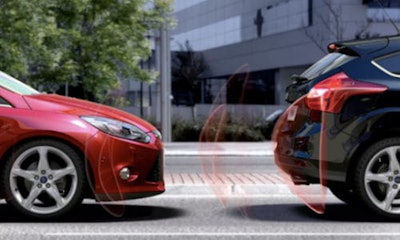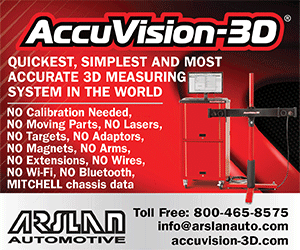
By Dylan O’Hagan
Toronto, Ontario — March 22, 2016 — First it was seatbelts, then air bags and now automatic emergency braking (AEB) could be the latest safety feature to be mandated for all new vehicles in the future. At least 20 large automakers have vowed to make it standard by September 1, 2022. The commitment involves 20 OEMs that together make up 99 percent of the US auto market.
The vow is to make full automatic braking, not just collision warnings, standard in all new vehicles within just a few years. The automakers involved include Audi, BMW, FCA, Ford, General Motors, Honda, Hyundai, Jaguar Land Rover, Kia, Maserati, Mazda, Mercedes, Mitsubishi, Nissan, Porsche, Subaru, Tesla, Toyota, Volkswagen and Volvo.
Toyota has jumped ahead of the pack, with a recent announcement that the company will begin offering automatic braking as a standard feature on most Lexus and Toyota models by the end of 2017. Actually, the company is going even further. A statement from Toyota says that the company will begin to include the Lexus Safety System or Toyota Safety Sense packages on almost every new vehicle by the end of 2017.
Toyota Safety Sense includes the company’s Pre-collision System (PCS) for vehicle detection, a lane departure alert system and lights that automatically switch from high to low-beams if an oncoming vehicle is detected. The Lexus Safety System is similar, but adds dynamic radar cruise control. This functions in a similar way to conventional cruise control, but uses sensors to maintain a constant distance between vehicles.
It’s a step in the right direction and follows in the footsteps of previous safety features, according to Pete Karageorgos, Director, Consumer and Industry Relations for the Insurance Bureau of Canada (IBC).
IBC is the national industry association representing Canada’s private home, auto and business insurers. Karageorgos alludes to past safety features being made standard and says if it helps reduce the frequency or severity of crashes, it’s a positive.
“Anything that will minimize a likelihood of a crash is always a good thing,’ he says. “As an industry association we advocated for things like graduated licensing, mandatory seat belt use and appropriate head rests in vehicles to help minimize injuries and crashes.”
AEB technology is already available in Canada and is featured on some new vehicles. How it performs in Canada’s cold winters is something that Transport Canada is already looking into.
“Transport Canada is evaluating this technology and has conducted tests on a variety of vehicles with it. We will continue our tests in order to fully assess AEB under Canadian climactic conditions,” says Mélany Gauvin, Media Relations for Transport Canada.
Karageorgos says he hopes that by implementing this technology on all new vehicles, it will reduce both the frequency of crashes and the severity. The effectiveness of emergency automatic braking to help reduce crashes has yet to be seen for Karageorgos however. He says from an insurance perspective, it’s always better to take a wait and see approach.
“This potentially could be a good thing but like most things, the insurance industry is based on data,” says Karageorgos. “So we’ll have to wait and see how this plays out down the road, if in fact it provides a reduction in the number of crashes.”
However, there have already have been studies conducted on AEB systems by the Insurance Institute for Highway Safety (IIHS), an organization based in the US. The IIHS is a not-for-profit organization dedicated to educating the public about road safety and reducing the number of deaths, injuries and property damage from crashes. The organization’s studies showed that AEB can cut around 40 percent of rear-end crashes in the US on average, while collision warning systems alone cut down on rear-end crashes by 23 percent.
How much AEB systems will cost to repair is another unanswered question. With new technology comes new repair methods and it could add cost to collision repairs. Karageorgos notes that companies have to realize how much it will cost to fix and consider how it may impact the collision repair industry.
“At the end of the day, you also have to recognize that some of these items come with additional costs to repair, sensors and things like that,” he says. “So it’s not always a wash, today’s cars are technologically a lot more challenging to repair than prior models. That’s something that needs to be considered.”





















